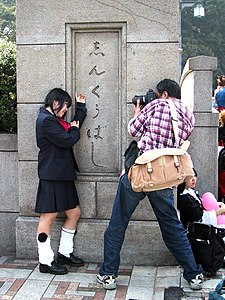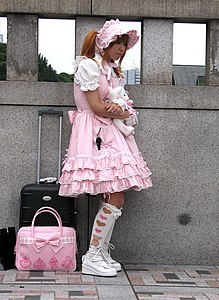Jingūbashi
Jingu Bashi 神宮橋 | |
|---|---|
 The bridge on a rainy day, 2020 | |
| Coordinates | 35°40′11″N 139°42′08″E / 35.6697°N 139.7023°E |
| Carries | Traffic |
| Crosses | Yamanote Line |
| Other name(s) | Shrine Bridge |
| Followed by | The original bridge |
| Characteristics | |
| Material | Reinforced concrete |
| Total length | 20.4-metre |
| Width | 29.1-metre |
| History | |
| Opened | 1982 |
| Location | |
 | |
Jingūbashi (神宮橋, Jingūbashi), lit. Shrine Bridge, also known as Harajuku Bridge or Harajuku Cosplay Bridge, is a bridge that passes over the Yamanote Line between Harajuku Station and the entrance to the Meiji Shrine in Tokyo, Japan. Formerly a pedestrian bridge, it is now open to traffic. With its wide pedestrian area, it is well known as a spot for cosplayers and fashion performers, which in turn led to it becoming a tourist attraction.
History and technical specifications
Jingūbashi is a 20.4-metre (67 ft)-long, 29.1-metre (95 ft)-wide bridge made out of reinforced concrete.[1] It dates from 1982, when it replaced the original bridge that had opened in September 1920. The original bridge was one of the first reinforced concrete bridges in Japan. The current bridge inherits the design and some of the elements of the original bridge, such as the ornamental railing pillars.[2]
Cultural significance
The Harajuku area is known internationally as a center of Japanese youth culture and fashion.[3] Jingu Bridge has become one of the locality's popular landmarks. Since the 1960s, it has attracted numerous cosplayers, performers, people dressed in visual kei, lolita fashion (sometimes in gothic variations), or similar outfits, and tourists.[4] [5] [6] [7]
The area was pedestrian-only and closed to motor-vehicles until 1995; the opening of the area to motor vehicles has been credited with lessening the popularity of the area. Jingu Bridge itself has become somewhat less popular in the second decade of the 21st century, with a 2017 CNN guide suggesting that "it's been noted that Harajuku Girls no longer gather in large numbers on Jingu Bridge ... these days".[8]
Gallery
-
Gothic Lolita and Aristocrat styles at Jingu Bashi in 2007
-
People dressed in visual kei style at Jingu Bashi in 2006
-
Cosplayer and photographer at Jingu Bashi in 2004
-
Lolita style on display at Jingu Bashi in 2007
-
Cosplayers on display at Jingu Bashi, 2004
-
Cosplayers on display at Jingu Bashi in 2005
-
Several people in 2007
References
- ^ The East. East Publications. 2006. p. 25.
- ^ "13. Jingu Bashi" 13. 神宮橋 (in Japanese). Retrieved 7 August 2017.
- ^ Imada, Kaila (2017-07-28). "50 Things to do in Harajuku". Time Out Tokyo. Retrieved 2017-09-05.
- ^ Haley, Ashley (2011-12-14). "Jingu Bashi - Harajuku Girl Hangout". JapanTravel. Retrieved 2017-08-07.
- ^ Perry, Greg (2009-02-09). An Other Road Into the Heartland: After Basho, Buddha, and Japan. Lulu. p. 13. ISBN 978-0-557-04480-1.
- ^ Kawamura, Yuniya (2013-08-15). Fashioning Japanese Subcultures. Berg. pp. 65–66. ISBN 9780857852151.
- ^ Insight Guides: Japan. Apa Publications (UK) Limited. 2016-02-01. p. 31. ISBN 9781780059075.
- ^ Nakagawa, Ulara (2017-07-12). "15 sights that make Tokyo so fascinating". CNN Travel. Retrieved 2017-08-07.
External links
 Media related to Jingu Bashi at Wikimedia Commons
Media related to Jingu Bashi at Wikimedia Commons







